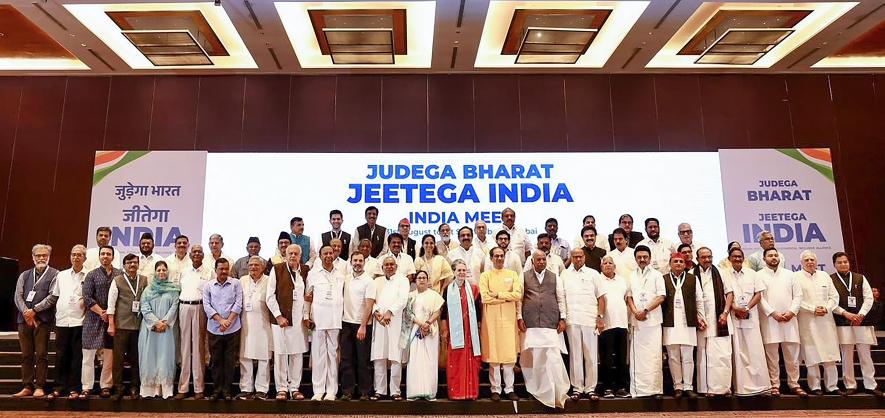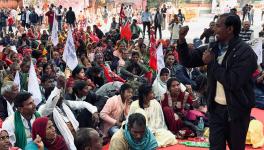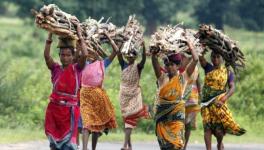Economy: A Blueprint for INDIA Bloc’s NCMP

Opposition's Indian National Developmental Inclusive Alliance (INDIA) leaders pose for a group photograph ahead of their meeting, in Mumbai, Friday, Sept. 1, 2023. Image Courtesy: PTI
The Indian National Developmental Inclusive Alliance (INDIA) has emerged as the principal opposition to the Bharatiya Janata Party (BJP). INDIA’s contest with BJP spans both the political-organisational and political programme realms. While most of the attention has been on the former, the latter has not been given its due regard, which is crucial since the rise of the neo-fascist dispensation in India has involved the attainment of virtual hegemony of neo-fascism over the neoliberal project.
One of the necessary factors in the process of virtual hegemony is the entanglement of most (but not all) opposition parties within the confines of the neoliberal project. The constituents of INDIA need to clearly comprehend that they cannot resist and replace BJP government on a sustainable basis unless they break with the neoliberal project. This is exemplified by the experience of the United Progressive Alliance (UPA) government between 2004 and 2014 whose further enmeshing within the rubric of the neoliberal project led to the return of BJP to the helm of the Union government of India.
How can INDIA break with the neoliberal project in India? Such a break has to span all the domains of public life: authentic restoration of the movement toward democracy, gender justice, social justice, federalism, social regulation of the corporate sector, ecological viability and detoxification of the public sphere which would require inter alia overcoming the crises of the Indian economy.
The Indian economy has been confronted with a series of crises that are characteristic of a neoliberal trajectory, including rising unemployment, under-employment and precarity, persistent agrarian crisis, retrogression of medium and small-scale sector firms, heightened inequality and stagnation of productive investment. These crises cannot be overcome as long the economy is perched along a neoliberal trajectory, as exemplified by what happened during the Covid-19 pandemic.
We discuss some alternative economic policy proposals that could go some way in moving the Indian economy away from its crises-ridden neoliberal trajectory.
The INDIA bloc could draw lessons from past experiences of economic growth while setting out its National Common Minimum Programme (NCMP) involving alternative policies for Lok Sabha elections 2024. While setting out our proposals for a NCMP we critically draw upon past experience especially the Budget Speeches of 1991, 2004-05, 2014-15 and 2024-25.
The Economic Dimension of UPA I and II
As per the Budget Speech, 2004-05 of Finance Minister, P. Chidambaram of the United Progressive Alliance (UPA-I which was critically supported by the Left Parties) proposed to achieve the following goals: (1) maintaining a growth rate of 7-8% per year for a sustained period; (2) providing universal access to quality basic education and health; (3) generating gainful employment in agriculture, manufacturing and services, and promoting investment; (4) assuring 100 days’ employment to the breadwinner in each family at the minimum wage; (5) focusing on agriculture and infrastructure; (6) accelerating fiscal consolidation and reform; and (7) ensuring higher and more efficient fiscal devolution. The Economic Survey 2004-2005 reiterated some of these objectives.
Major programmes initiated in this regard in 2004-05 include launching of the National Food for Work Programme in 150 most backward districts; introduction of the National Rural Employment Guarantee Bill, 2004 in Parliament on December 21, 2004 to provide for enhancement of livelihood security of the poor in rural areas; provision of additional Rs.12,000 crore of Gross Budgetary Support (GBS) for Plan programmes like Food for Work, Sarva Shiksha Abhiyan, mid-day cooked–meal scheme, basic healthcare, Accelerated Irrigation Benefit Programme, drinking water, and roads; increase in coverage of Antyodaya Anna Yojana from 1.5 crore to 2 crore families; improving facilities for universal education by imposition of a cess of 2 per cent on Union taxes and duties; upgrading Industrial Training Institutes (ITIs) over the next 5 years; and introduction of a new Universal Health Insurance Scheme for the poor and a special group insurance scheme (Economic Survey, 2004-05).
The Economic Survey 2004-2005 was aware of the exclusionary economic growth process undertaken since the neoliberal project became entrenched in 1991. However, UPA-I, and especially UPA-II, became further enmeshed in the ambit of international finance capital. For instance, the Budget Speech of 2009-10 argues that “it is time that we complete the process that was started in 1991”.
But the vigorous pursuit of neoliberal policies especially by UPA-II led to the establishment of the BJP government. This was the decisive element in the attainment of hegemony of neo-fascism over the neo-liberal project in India.
Experiences of UPA-II and Modi-II
Figures 1.1 and 1.2 show the share of corporate-taxes in gross tax revenue declined from 34% in 2012-13 (during the tenure of UPA-II) to 27% in 2024-25 (during the tenure of Modi-II) year which is indicative of the class bias of the latter. During this period there has been a trend toward an increase in share of income-tax from 19% to 29%, which indicates that the Modi-II government is further shifting the tax burden from corporate capital to the salaried sections of the working people. Moreover, the same class bias is confirmed by the decline in the share of wealth tax in total tax revenue to less than 1%.
Turning to the economic dimension of federalism, the ratio of development expenditure of states to their share of gross tax revenue has increased. Moreover, all revenues from cesses, levies etc. are not shareable with the states. The share of cesses and levies in gross tax revenue is also rising. As the shares of cesses and surcharges increased from 10% in Gross Tax Revenue of the Centre in 2011-12 to 25% during 2021-22 demonstrating that states are losing their fiscal capacity. These trends indicate that there has been a retrogression of the powers of state governments during the tenure of the Modi-I and Modi-II governments.
Figure 1.3 shows that the share of development expenditure of Indian states to total revenue receipts increased slightly from 77% in UPA-I period to 79% in UPA-II and significantly increased to 84% in the Modi-I & II periods (2014-15 to 2022-23) of nine years, showing a deteriorating fiscal space for Indian states in comparison to the Centre during the Modi regime, even though it has been disingeniously claimed that the share of the states in financial resources has increased.
The tax structure in India has also become regressive as far as small-scale firms are concerned. The share of Goods and Services Tax (GST) has increased, which tends to disproportionately impact such firms adversely. This is the case since small firms, unlike large firms, are less capable of shifting the burden of taxation by increasing output prices and decreasing input prices.
Likewise (Figure 1.2), the share of custom duties has declined, which is reflective of the fact that firms in the small sector are being subjected to predatory competition by foreign firms.
These retrogressive changes in tax structure need to be reversed. A return to the tax structure of 2014-15 could be the first goal of any change in this state of affairs.
Trends in Shares of Public Welfare: 2012-13 to 2014-15 and 2022-23 to 2024-25
Let us turn to expenditure now. Figures 2.1 and 2.2 show a declining role of public welfare in India. The percentage shares of economic services, social services and grants-in-aid and contribution in total revenue account disbursement of the budget were 8%, 13% and 13 % during 2012-13.
The share of social services declined to 4% in 2014-15 and the respective shares of economic services and grants-in-aid increased to 21% and 21% in 2014-15 in the same year (Figure 2.1). However, the respective three shares in 2024-25 are 16%, 6%, and 16%. This clearly demonstrates the anti-social sector orientation of the Modi-I and Modi-II governments.
In order to set this right, there is a need to increase the shares of these components of social expenditure to at least at 8% of social services, 21% of economic services and 21% of grants-in-aid, which was the case before 2014. We propose that this be a component of NCMP.
Public Disbursement of Economic and Social Services
Let us turn to other trends in public expenditure. The total amount of nominal revenue disbursement by the Union government was Rs 37.84 lakh crore in 2022-23, increased by 3.1% to Rs 39.0 lakh crore in 2023-24 and rose by 3.3% to Rs 40.30 lakh crore in 2024-25 (Figures 2.3, 2.4 and 2.5), reflecting a real decline in the growth rate of total revenue disbursement, as inflation rate in 2022, 2023 and 2024 was approximately at 6.1%, 6.5% and 5.1%, respectively.
The magnitude of public funding for general administrative services, the most significant in volume, rose from Rs. 16.8 lakh crore in 2022-23 to Rs.18.8 lakh crore in 2023-24 to Rs.19.9 lakh crore in 2024-25.
The next significant component of public expenditure, namely, spending on economic services, declined from Rs. 12.3 lakh crore in 2022-23 to Rs. 11.65 lakh crore in 2023-24 but increased marginally to Rs. 11.68 crore in 2024-25, reflecting a real decline, given the previously mentioned rates of inflation in this period.
Grants also declined from Rs. 6.58 lakh crore in 2022-23 to Rs. 5.97 lakh crore in 2023-24 and slightly increased to Rs. 6.28 lakh crore in 2024-25, which once again amounted to a real decline. The expenditure on social services increased slightly from Rs. 2.07 lakh crore in 2022-23 to Rs 2.42 lakh crore but declined to Rs. 2.26 lakh crore in 2024-25, which amounted to virtually no change in real terms in this period.
Figure 2.5 shows that a real decline (or stagnation) in all four types of social, economic, grants and general services of public disbursement during 2024-25, as compared to 2023-24. The growth rate of these expenditures either lower than the inflation rate or outright during the period 2023-24 to 2024-25. This demonstrates that there is a significant gulf between the rhetoric and action of the Modi-II government as far as public welfare is concerned.
General, Economic, Social Services and Grants
As previously mentioned, the share of general services disbursement is highest at 49% in 2024-25 (Fig. 2.2), however real growth rate of total revenue disbursement is negative as nominal growth rate is 3.1% in 2024-25 (Fig. 2.5) and inflation rate expected at 5.1% in 2024 reflecting -2.0% real growth rate during 2024-25.
Further, the level of spending on pensions and other retirement benefits declined from Rs. 2.42 lakh crore in 2022-23 to Rs. 2.41 lakh crore during 2024-25 (Fig 3.1).
Given that senior citizens are among the most vulnerable in India, there is an urgent need to reverse this negative trend by shifting from the New Pension Scheme (NPS) to the Old Pension Scheme (OPS), and this too needs to be a part of NCMP. Some parties that are part of the INDIA bloc, such as the Communist Party of India-Marxist (CPI-M) have explicitly specified this in their manifesto for Lok Sabha elections 2024.
The share of public disbursement on general and technical education declined over the years (2023-24 to 2024-25-Fig.3.2), the shares of medical and public health and family welfare, welfare of SCs/STs/OBCs and Minorites and labour employment and skill-development are also very low (less than 0.5% and 1%) over the years. This reflects the low priority that the current Union government accords to socio-economic development and inclusion of the marginalised.
Figure 3.3 shows a declining share from 10% to 9% of the revenue disbursement on agriculture and allied activities. There is also a stagnant and low public spending on rural development and employment in terms of expenditure shares and a declining share of general economic services and transport during the same period of two years. This trend, which is a cause of the agrarian crisis in India, needs to be reversed through adoption of measures such as a legal guarantee of MSP (minimum support price) for crops, universal public distribution system (PDS) and greater allocation to MNREGS (the rural job guarantee scheme). We propose that these policy measures must be incorporated into the NCMP.
The declining levels and share of grants to states and Union territories (UTs) from 2022-23 to 2024-25 is another area of concern. The grants to states declined from Rs. 5.8 lakh crore (15%) in 2022-23 to Rs. 5.6 lakh crore (13%) in 2024-25, while grants to UTs declined from Rs. 0.71 lakh crore (2%) to Rs. 0.57 lakh crore (1%) over the recent year.
In other words, the previously mentioned increase in the ratio of development expenditure of states to their share of gross tax revenue has been compounded by the decrease in grants from the union government to the states and union territories.
Some Economic Policy Initiatives for NCMP 2024
After synoptically examining economic policy measures by the Modi-I and Modi-II governments, it was possible to see that these measures amounted to a retrogression from what happened till 2014. However, this does not imply that what is required is a return to the state of affairs that existed till 2014.
As pointed out earlier, it was the further entanglement of the UPA governments (over time) in the neoliberal project that principally led the BJP back to power in 2014. The aim of this comparative exercise was, in fact, to demonstrate that the post-2014 state of affairs is underwhelming even by the fairly bargain standards of what was the case before 2014.
Therefore, we propose 15 key economic policy issues that could form part of the NCMP of the INDIA alliance.
1. A guaranteed MSP that is one immediate policy intervention to deal with agrarian crisis;
2. A universal PDS to deal with the persisting problems of nutrition;
3. Extend Mahatma Gandhi National Rural Employment Guarantee Scheme (MNREGS) to include urban areas while expanding it in rural areas;
4. Further public policy support for small scale industries to deal with unemployment, since these industries are labour intensive when compared to the corporate sector. These measures could include calibrated increase in custom duties by 15% besides the deployment of subsidies (including a reduction in GST rates for such firms as a prelude to a comprehensive review of the GST itself).
5. Initiate a move toward universal public health and public education (by jettisoning the National Education Policy 2020);
6. Replace NPS by OPS to develop a modicum of social security for senior citizens and move towards universal basic pension for all senior citizens.;
7. Scrapping of the Agnipath Scheme of Defence Services employment to re-establish a secure basis for national security;
8. Policy initiatives for inclusion of socially disadvantaged sections of society, women, SC, ST, OBCs, Muslim and other minorities such as extending reservation to the private sector.
9. An increase in share of states in gross tax-revenue by rationalizing and making progressive changes in the finance commission apart from increasing the borrowing limit of state governments;
10. Increase in share of social services up to 8% of total revenue disbursement;
11. Rise in grants-in-aid up to 21% of total revenue disbursement;
12, Augmentation of share of economic services in total revenue disbursement to 21%;
13. Enhance wealth tax to 1% to tax individuals with more than Rs. 10 crores of wealth;
14. An increase in share of corporate-tax in gross tax-revenue to 34%.
15. A rationalisation of income tax by making it more progressive thereby reducing the effective income tax rate on the salaried segment of the working people while increasing it for the super-rich and rich.
This article does “costed” expenditure policy suggestions for the NCMP since we believe that the tax policy suggestions given are adequate to finance these expenditures. It is also noteworthy that macroeconomically, government expenditure that is financed by a tax on profits will leave the total magnitude of profits unchanged along with an increase in output (in a demand constrained economy).
These proposals regarding the NCMP involve a break with the neoliberal project. A fundamental prescription of the neoliberal project (which is however fallacious in terms of macroeconomics) is that: private investment is the fundamental driver of economic activity. Therefore, government policy ought to provide “incentives” to private capital in order to obtain the requisite volume of economic growth.
This prescription was never followed in practice in the sense that capitalist states that were strategically autonomous always implemented an industrial policy. It however had two political economy rationales: one, domestically it legitimised the state’s attack on the working people (with different segments being differentially targeted) in the name of providing “incentives” to private investment; two, it provided ideological cover for capitalist states (apart from the US where it continued in disguise) to increasingly disengage from a meaningful industrial policy (of the dirigiste kind) without losing all credibility in the eyes of the working people. The effectiveness of this neoliberal project was driven by the working of international finance capital.
The ongoing conflict in Ukraine and the strategic impasse confronting the US while contending with both China and Russia has compelled the US to adopt explicit industrial policy initiatives (sometimes incorrectly interpreted as the return of industrial policy in the US). This has necessarily weakened the second political economy rationale of the neoliberal prescription opening up policy space in countries the world over.
These policy suggestions advanced for the NCMP involve a utilisation of this widening policy space which inter alia involves a break with the neoliberal project. But this break cannot become material unless capital controls on international finance are deployed.
Narender Thakur is associate professor, Department of Economics, BR Ambedkar College, University of Delhi. C. Saratchand is professor, Department of Economics, Satyawati College, University of Delhi. The views are personal.
Get the latest reports & analysis with people's perspective on Protests, movements & deep analytical videos, discussions of the current affairs in your Telegram app. Subscribe to NewsClick's Telegram channel & get Real-Time updates on stories, as they get published on our website.






















